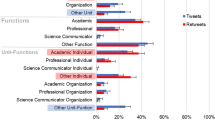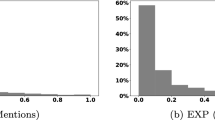Abstract
This paper presents preliminary findings regarding automated bots mentioning scientific papers about COVID-19 publications on Twitter. A quantitative approach was adopted to characterize social and posting patterns of bots, in contrast to other users, in Twitter scholarly communication. Our findings indicate that bots play a prominent role in research dissemination and discussion on the social web. We observed 0.45% explicit bots in our sample, producing 2.9% of tweets. The results implicate that bots tweeted differently from non-bot accounts in terms of the volume and frequency of tweeting, the way handling the content of tweets, as well as preferences in article selection. In the meanwhile, their behavioral patterns may not be the same as Twitter bots in another context. This study contributes to the literature by enriching the understanding of automated accounts in the process of scholarly communication and demonstrating the potentials of bot-related studies in altmetrics research.
Access this chapter
Tax calculation will be finalised at checkout
Purchases are for personal use only
Similar content being viewed by others
References
Sugimoto, C.R., Work, S., Larivière, V., Haustein, S.: Scholarly use of social media and altmetrics: a review of the literature. J. Assoc. Inf. Sci. Technol. 68, 2037–2062 (2017). https://doi.org/10.1002/asi.23833
Robinson-Garcia, N., van Leeuwen, T.N., Rafols, I.: Using altmetrics for contextualised mapping of societal impact: from hits to networks. Sci. Public Policy 45, 815–826 (2018). https://doi.org/10.1093/scipol/scy024
Van Noorden, R.: Online collaboration: scientists and the social network. Nature 512, 126–129 (2014). https://doi.org/10.1038/512126a
Hassan, S.-U., Imran, M., Gillani, U., Aljohani, N.R., Bowman, T.D., Didegah, F.: Measuring social media activity of scientific literature: an exhaustive comparison of scopus and novel altmetrics big data. Scientometrics 113(2), 1037–1057 (2017). https://doi.org/10.1007/s11192-017-2512-x
Darling, E., Shiffman, D., Côté, I., Drew, J.: The role of Twitter in the life cycle of a scientific publication. Ideas Ecol. Evol. 6 (2013). https://doi.org/10.4033/iee.2013.6.6.f
Robinson-Garcia, N., Costas, R., Isett, K., Melkers, J., Hicks, D.: The unbearable emptiness of tweeting—about journal articles. PLoS ONE 12, e0183551 (2017). https://doi.org/10.1371/journal.pone.0183551
Robinson-Garcia, N., Arroyo-Machado, W., Torres-Salinas, D.: Mapping social media attention in Microbiology: identifying main topics and actors. FEMS Microbiol. Lett. 366 (2019). https://doi.org/10.1093/femsle/fnz075
Haustein, S.: Scholarly Twitter metrics. In: Glänzel, W., Moed, H.F., Schmoch, U., Thelwall, M. (eds.) Handbook of Quantitative Science and Technology Research (2018). https://arxiv.org/abs/1806.02201
Haustein, S., Bowman, T.D., Holmberg, K., Tsou, A., Sugimoto, C.R., Larivière, V.: Tweets as impact indicators: examining the implications of automated “bot” accounts on Twitter. J. Assoc. Inf. Sci. Technol. (2016). https://doi.org/10.1002/asi.23456
Yu, H.: Context of altmetrics data matters: an investigation of count type and user category. Scientometrics 111, 267–283 (2017). https://doi.org/10.1007/s11192-017-2251-z
Haustein, S., Toupin, R., Alperin, J.P.: “Not sure if scientist or just Twitter bot” Or: who tweets about scholarly papers (2018). https://www.altmetric.com/blog/not-sure-if-scientist-or-just-twitter-bot-or-who-tweets-about-scholarly-papers/
Aljohani, N.R., Fayoumi, A., Hassan, S.-U.: Bot prediction on social networks of Twitter in altmetrics using deep graph convolutional networks. Soft. Comput. 24(15), 11109–11120 (2020). https://doi.org/10.1007/s00500-020-04689-y
Kousha, K., Thelwall, M.: COVID-19 publications: database coverage, citations, readers, tweets, news, Facebook walls, Reddit posts. Quant. Sci. Stud. 1–24 (2020). https://doi.org/10.1162/qss_a_00066
Chu, Z., Gianvecchio, S., Wang, H., Jajodia, S.: Detecting automation of twitter accounts: are you a human, bot, or cyborg? IEEE Trans. Dependable Secur. Comput. 9, 811–824 (2012). https://doi.org/10.1109/TDSC.2012.75
Kantepe, M., Ganiz, M.C.: Preprocessing framework for Twitter bot detection. In: 2017 International Conference on Computer Science and Engineering (UBMK), pp. 630–634. IEEE (2017). https://doi.org/10.1109/UBMK.2017.8093483
Oentaryo, R.J., Murdopo, A., Prasetyo, P.K., Lim, E.-P.: On profiling bots in social media. In: Spiro, E., Ahn, Y.-Y. (eds.) SocInfo 2016. LNCS, vol. 10046, pp. 92–109. Springer, Cham (2016). https://doi.org/10.1007/978-3-319-47880-7_6
Kudugunta, S., Ferrara, E.: Deep neural networks for bot detection. Inf. Sci. 467, 312–322 (2018). https://doi.org/10.1016/j.ins.2018.08.019
Gilani, Z., Kochmar, E., Crowcroft, J.: Classification of Twitter accounts into automated agents and human users. In: Proceedings of the 2017 IEEE/ACM International Conference on Advances in Social Networks Analysis and Mining 2017, pp. 489-496 (2017). https://doi.org/10.1145/3110025.3110091
Sedhai, S., Sun, A.: HSpam14: a collection of 14 million tweets for hashtag-oriented spam research. In: Proceedings of the 38th International ACM SIGIR Conference on Research and Development in Information Retrieval, pp. 223–232 (2015). https://doi.org/10.1145/2766462.2767701
Author information
Authors and Affiliations
Corresponding author
Editor information
Editors and Affiliations
Rights and permissions
Copyright information
© 2020 Springer Nature Switzerland AG
About this paper
Cite this paper
Ye, Y.E., Na, JC. (2020). Profiling Bot Accounts Mentioning COVID-19 Publications on Twitter. In: Ishita, E., Pang, N.L.S., Zhou, L. (eds) Digital Libraries at Times of Massive Societal Transition. ICADL 2020. Lecture Notes in Computer Science(), vol 12504. Springer, Cham. https://doi.org/10.1007/978-3-030-64452-9_27
Download citation
DOI: https://doi.org/10.1007/978-3-030-64452-9_27
Published:
Publisher Name: Springer, Cham
Print ISBN: 978-3-030-64451-2
Online ISBN: 978-3-030-64452-9
eBook Packages: Computer ScienceComputer Science (R0)




